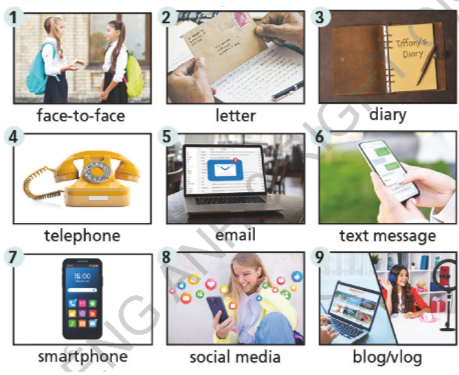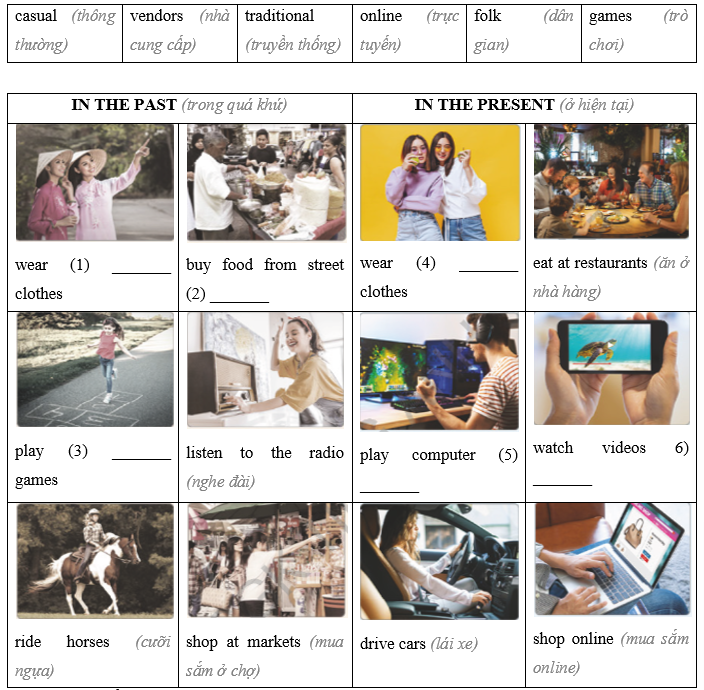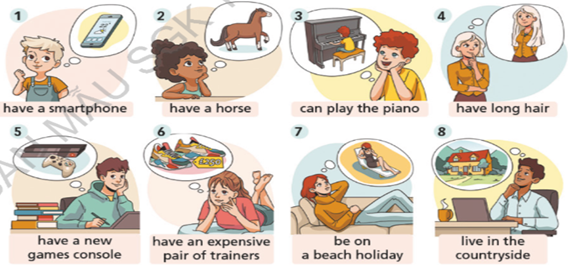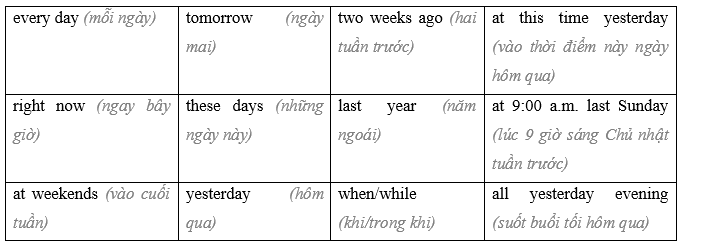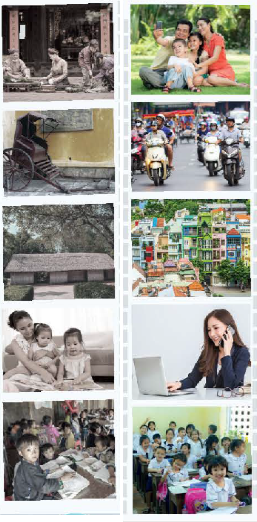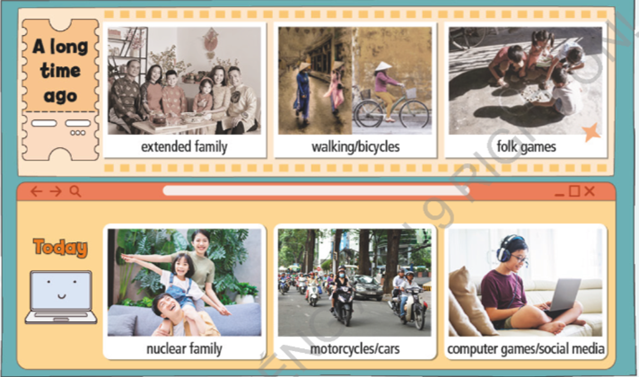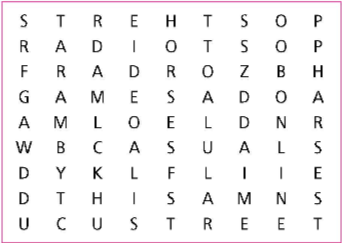Giải SGK, SBT Unit 1. Life - past and present Right on!
Giải SGK, SBT Unit 1. Life - past and present Right on!
Pronunciation (/t/ - /d/)
2. Listen to and notice the pronunciation of the underlined parts. Practise saying the words with your partner.
(Nghe và chú ý cách phát âm các phần được gạch chân. Thực hành nói các từ với đối tác của bạn.)
|
diary |
send |
write |
media |
present |
|
friend |
talk |
today |
telephone |
communicate |
Listening
3. Listen to five people talking about the ways of communication they prefer. Match the Speakers (1-5) to the ways of communication (A-E).
(Hãy nghe năm người nói về cách giao tiếp mà họ ưa thích. Nối Người phát biểu (1-5) với cách giao tiếp (A-E).)
|
Speaker 1 |
|
A. social media |
|
Speaker 2 |
|
B. smartphone |
|
Speaker 3 |
|
C. letter |
|
Speaker 4 |
|
D. text message |
|
Speaker 5 |
|
E. face-to-face |
7. Read the text again and decide if the statements (1-5) are R (right), W (wrong) or DS doesn’t say).
(Đọc lại văn bản và quyết định xem các câu (1-5) là R (đúng), W (sai) hay DS (không nói).)
|
1. In the past, people used carrier pigeons to deliver messages across long distances. |
|
|
2. Everybody used to write in a diary about their daily lives in the past. |
|
|
3. Today, people spend a lot of time online, so they speak face-to-face less often. |
|
|
4. People nowadays post updates about their lives on social media. |
|
|
5. Blogs are more popular than emails these days. |
|
Present Simple - Present Continuous
1. Match the sentences to the uses of the tenses.
(Nối các câu với cách sử dụng các thì.)
|
Present Simple |
Present Continuous |
|||||||||||||||||||||
|
|
|||||||||||||||||||||
|
a. I post a new vlog every week. (Tôi đăng một vlog mới mỗi tuần.) b. They don’t like going on social media. (Họ không thích lên mạng xã hội.) c. The post office opens at 8:00 a.m. (Bưu điện mở cửa lúc 8 giờ sáng) d. I go to school by bus. (Tôi đến trường bằng xe buýt.) |
e. I am sending you an email tonight. (Tối nay tôi sẽ gửi email cho bạn.) f. Ann isn’t writing in her diary now. (Bây giờ Ann không viết nhật ký nữa.) g. He’s using the telephone today because his smartphone is broken. (Hôm nay anh ấy sử dụng điện thoại vì điện thoại thông minh của anh ấy bị hỏng.) |
6. Match the sentences to the uses of the tenses.
(Nối các câu với cách sử dụng các thì.)
|
Past Simple |
|
||||||||||||
|
a. He recorded a vlog, edited the video and posted it online yesterday. (Anh ấy đã quay một vlog, chỉnh sửa video và đăng lên mạng ngày hôm qua.) b. I didn’t send a letter to my aunt last week. (Tuần trước tôi đã không gửi thư cho dì tôi.) |
|||||||||||||
|
Past Continuous |
|
||||||||||||
|
c. She was writing a blog when I arrived at her house. (Cô ấy đang viết blog khi tôi đến nhà cô ấy.) d. The children were watching vlogs all yesterday evening. (Bọn trẻ đã xem vlog suốt tối hôm qua.) e. I was talking to my friend on the phone at 8:00 p.m. yesterday. (Tôi đang nói chuyện điện thoại với bạn tôi lúc 8 giờ tối hôm qua.) f. John was reading books while Kate was watching TV last night. (John đang đọc sách trong khi Kate đang xem TV tối qua.) |
2. Listen to Robert and his grandfather talking about life in the past and in the present. Decide if the statements (1-5) are R (right) or W (wrong).
(Hãy nghe Robert và ông nội kể về cuộc sống xưa và nay. Quyết định xem các câu (1-5) là R (đúng) hay W (sai).)
|
1. Robert is playing his favourite computer game right now. (Hiện tại Robert đang chơi trò chơi máy tính yêu thích của anh ấy.) |
£ |
|
2. Robert’s grandfather loved playing folk games when he was a child. (Ông nội của Robert khi còn nhỏ rất thích chơi các trò chơi dân gian.) |
£ |
|
3. Robert is playing games online with his friends this weekend. (Robert sẽ chơi trò chơi trực tuyến với bạn bè vào cuối tuần này.) |
£ |
|
4. Robert thinks he should spend more time outside. (Robert nghĩ anh ấy nên dành nhiều thời gian hơn ở bên ngoài.) |
£ |
|
5. Robert’s grandfather wants to try computer games. (Ông của Robert muốn thử chơi game trên máy tính) |
£ |
Bài nghe:
Grandpa: Hi, Robert. What are you doing?
Robert: Hi, Grandpa. I'm playing my favorite computer game. Did you play computer games when you were my age?
Grandpa: No, I didn't. There weren't any computer games or video games when I was a child.
Robert: Really? Weren't you bold all the time?
Grandpa: No, not at all. I still knew how to have fun.
Robert: What did you do for fun?
Grandpa: I spent a lot of time with my neighborhood friend. We loved playing folk games together.
Robert: Oh, I like playing games with my friends too, but we play online. In fact, I'm playing with them next weekend.
Grandpa: I wish you knew what life was like in the past. We didn't spend all our free time sitting in front of a screen. We often played outside in the fresh air.
Robert: You are right, Grandpa. I should go outside more often, but maybe you should try computer games too.
Grandpa: No, thank you. I'm too old for that.
1. Read the dialogue and fill in the gaps (1-4) with the sentences (A-D). Listen and check.
(Đọc đoạn hội thoại và điền vào chỗ trống (1-4) bằng các câu (A-D). Nghe và kiểm tra.)
|
A. Today, they watch videos online. (Ngày nay, họ xem video trực tuyến.) B. Things were a lot different in the past. (Mọi thứ đã khác rất nhiều trong quá khứ.) C. Oh, how interesting! (Ồ, thật thú vị!) D. Today, they were casual clothes. (Hôm nay, chúng là quần áo bình thường.) |
Sarah: Hi, George! Are you giving your presentation today?
George: Oh, hi Sarah! Yes, I’m going to talk about life in the past and life in the present.
Sarah: (1) _____________________________. Were clothing styles in the past different from clothing styles today?
George: Yes. In the past, people wore traditional clothes. (2) _____________________________.
Sarah: What about entertainment? Was it different in the past?
George: Yes. In the past, people listened to the radio. (3) _____________________________.
Sarah: How was transport different in the past?
George: People walked or rode horses in the past. Today, many people drive cars or take buses or taxis to get around.
Sarah: Wow! (4) _____________________________.
George: They sure were!
Bài nghe:
Sarah: Hi, George! Are you giving your presentation today?
George: Oh, hi Sarah! Yes, I’m going to talk about life in the past and life in the present.
Sarah: Oh, how interesting! Were clothing styles in the past different from clothing styles today?
George: Yes. In the past, people wore traditional clothes. Today, they were casual clothes.
Sarah: What about entertainment? Was it different in the past?
George: Yes. In the past, people listened to the radio. Today, they watch videos online.
Sarah: How was transport different in the past?
George: People walked or rode horses in the past. Today, many people drive cars or take buses or taxis to get around.
Sarah: Wow! Things were a lot different in the past.
George: They sure were!
3. Act out a similar dialogue. Use the dialogue in Exercise 1 as a model and the ideas from Exercise 1 (page 14) and/or your own ideas.
(Diễn lại một đoạn hội thoại tương tự. Sử dụng đoạn hội thoại trong Bài tập 1 làm mẫu và các ý tưởng từ Bài tập 1 (trang 14) và/hoặc ý tưởng của riêng bạn.)
Pronunciation: Linking sounds
(Phát âm: Liên kết các âm)
Listen and notice the linking sounds. Practice saying the sentences with your partner.
(Nghe và chú ý các âm thanh liên kết. Thực hành nói các câu với đối tác của bạn.)
1. What about clothing styles?
(Về kiểu dáng quần áo thì sao?)
2. Let’s watch videos online together.
(Hãy cùng nhau xem video trực tuyến.)
3. What was it like when you were young?
(Thời trẻ của bạn như thế nào?)
4. I usually eat at restaurants near my house.
(Tôi thường ăn ở nhà hàng gần nhà.)
5. Life in the past was much different from life in the present.
(Cuộc sống ngày xưa khác xa cuộc sống hiện tại rất nhiều.)
|
When one word ends in a consonant sound and the following word starts with a vowel sound, the final consonant sound often links to the beginning vowel sound. (Khi một từ kết thúc bằng một phụ âm và từ tiếp theo bắt đầu bằng một nguyên âm thì phụ âm cuối thường liên kết với nguyên âm đầu.) |
|
We use wish + Past Simple to express a wish for a thing/situation that is not real in the present. I wish I had a smartphone. (I don’t have a smartphone.) We wish we weren’t shy. (We are shy.) George wishes he could make a vlog. (George can’t make a vlog.) |
Tạm dịch:
|
Chúng ta sử dụng Wish + Past Simple để diễn tả một điều ước về một sự việc/tình huống không có thật ở hiện tại. Tôi ước gì tôi có một chiếc điện thoại thông minh. (Tôi không có điện thoại thông minh.) Chúng tôi ước mình không ngại ngùng. (Chúng tôi xấu hổ.) George ước gì anh ấy có thể làm một vlog. (George không thể làm vlog.) |
1. Rewrite the sentences using wish + Past Simple.
(Viết lại câu sử dụng Wish + Quá khứ đơn.)
1. He doesn’t have a social media account.
He wishes __________________________________________________.
2. She isn’t a famous travel blogger in her country.
She wishes __________________________________________________.
3. Their neighbourhood is noisy and polluted.
They wish ___________________________________________________.
4. Michael lives far from his office.
Michael wishes _______________________________________________.
5. Ann’s parents don’t let her own a smartphone.
Ann wishes __________________________________________________.
6. My grandparents can’t create an email address.
My grandparents wish _________________________________________.
5. Put the verbs in brackets into the correct tenses. Use the Present Simple, the Present Continuous or the Past Continuous.
(Chia động từ trong ngoặc vào thì đúng. Sử dụng thì Hiện tại đơn, Hiện tại tiếp diễn hoặc Quá khứ tiếp diễn.)
 |
Lily usually (1) _______ (use) her smartphone for communication and entertainment. Yesterday, she (2) _______ (update) her social media app on her smartphone when it (3) _______ (stop) working. Then, she (4) _______ (take) it to the electronics shop and (5) _______ (ask) them for help. They (6) _______ (repair) it all yesterday afternoon. At the moment, Lily (7) _______ (watch) videos online on her smartphone. In fact, she wishes she (8) _______ (have) a new smartphone, but her parents asked her to wait until her birthday. |
3. Read the text again and decide if the statements (1-5) are R (right), W (wrong) or DS (doesn’t say).
(Đọc lại văn bản và quyết định xem các câu (1-5) là R (đúng), W (sai) hay DS (không nói).)
|
1. An extended family often includes parents, children, grandparents, aunts, uncles and cousins. (Gia đình mở rộng thường bao gồm cha mẹ, con cái, ông bà, cô, chú, anh chị em họ.) |
☐ |
|
2. Hand-drawn carts were more popular than bicycle carts in the past. (Xe đẩy kéo tay ngày xưa phổ biến hơn xe đạp.) |
☐ |
|
3. Many Vietnamese people in the countryside live in small brick houses nowadays. (Hiện nay nhiều người Việt Nam ở nông thôn sống trong những ngôi nhà gạch nhỏ.) |
☐ |
|
4. Today in Việt Nam only men work outside the home. (Ngày nay ở Việt Nam chỉ có đàn ông làm việc bên ngoài nhà.) |
☐ |
|
5. In the past, most Vietnamese girls received a good education. (Trước đây, hầu hết con gái Việt Nam đều được học hành tử tế.) |
☐ |
5. Listen and repeat. Fill in each gap with the correct phrase from the list.
(Nghe và lặp lại. Điền vào mỗi chỗ trống với cụm từ đúng trong danh sách.)
|
extended family (đại gia đình) |
nuclear family (gia đình hạt nhân) |
do the housework (làm việc nhà) |
|
raise children (nuôi con) |
make a living (kiếm sống) |
support the family (nuôi sống gia đình) |
1. My parents’ salary is good enough to _______.
2. In my _______, there is my mum, dad, sister and me.
3. My _______ includes my parents, grandparents, aunt, uncle, cousins and me.
4. Women in the old days stayed home to _______ and teach them how to behave well.
5. A long time ago, only men used to _______ by working outside the home.
6. Today, all family members _______ to keep the house clean.
|
Culture Spot (Điểm văn hóa) Cyclos became a popular means of transport in Việt Nam’s cities around 100 years ago. You can still see cyclos in some places nowadays, but they are most popular with tourists. (Xích lô trở thành phương tiện giao thông phổ biến ở các thành phố Việt Nam khoảng 100 năm trước. Ngày nay bạn vẫn có thể nhìn thấy xích lô ở một số nơi nhưng chúng được khách du lịch ưa chuộng nhất.) |
Find information about a means of transport in the past in the UK. Is it popular today? Present it to the class.
(Tìm thông tin về một phương tiện giao thông ngày xưa ở Anh. Ngày nay nó có phổ biến không? Trình bày nó trước lớp.)
Writing
(A paragraph about your family life)
Task analysis
1. Read the task and complete the table.
(Đọc bài tập và hoàn thành bảng.)
|
Your school magazine wants its readers to send in a paragraph about their family life. Write a paragraph for the magazine (about 100-200 words). Include family type, family members, housing, family lifestyle and your opinion. (Tạp chí trường học của bạn muốn độc giả gửi một đoạn về cuộc sống gia đình của họ. Viết một đoạn văn cho tạp chí (khoảng 100-200 từ). Bao gồm loại gia đình, thành viên gia đình, nhà ở, lối sống gia đình và ý kiến của bạn.) |
|
Type of text (Loại văn bản) |
|
|
Readers (Độc giả ) |
|
|
Topic (Đề tài) |
|
|
Number of words (Số từ) |
|
|
What to include (Những gì cần bao gồm) |
|
Writing
(A paragraph about your family life)
Task analysis
1. Read the task and complete the table.
(Đọc bài tập và hoàn thành bảng.)
|
Your school magazine wants its readers to send in a paragraph about their family life. Write a paragraph for the magazine (about 100-200 words). Include family type, family members, housing, family lifestyle and your opinion. (Tạp chí trường học của bạn muốn độc giả gửi một đoạn về cuộc sống gia đình của họ. Viết một đoạn văn cho tạp chí (khoảng 100-200 từ). Bao gồm loại gia đình, thành viên gia đình, nhà ở, lối sống gia đình và ý kiến của bạn.) |
|
Type of text (Loại văn bản) |
|
|
Readers (Độc giả ) |
|
|
Topic (Đề tài) |
|
|
Number of words (Số từ) |
|
|
What to include (Những gì cần bao gồm) |
|
2. Read the paragraph. In which part (1-5) does the writer …?
(Đọc đoạn văn. Ở phần nào (1-5) người viết viết…?)
|
a |
|
describe the housing (mô tả nhà ở) |
|
b |
|
describe a family lifestyle (mô tả lối sống gia đình) |
|
c |
|
give an opinion (đưa ra ý kiến) |
|
d |
|
list family members (liệt kê các thành viên trong gia đình) |
|
e |
|
describe a family type (mô tả một kiểu gia đình) |
My family
(1) My family is a nuclear family. (2) There are four members: my father, mother, brother and me. (3) We live in a flat in a big city. It is small but comfortable. (4) My parents take an equal role in my family. They go to work to make a living and share the housework. My parents always respect our opinions. They let us decide on our clothing styles and hobbies. We usually spend time together. We watch TV in the evenings and go to the mall or the park at the weekend. (5) I love my family because we are always there for each other.
4. Match the facts/opinions (1-3) with the details (a-c) that support them.
(Nối các sự kiện/ý kiến (1-3) với các chi tiết (a-c) hỗ trợ chúng.)
|
1 |
|
We love hanging out together. (Chúng tôi thích đi chơi cùng nhau.) |
|
2 |
|
My family is an extended family. (Gia đình tôi là một đại gia đình.) |
|
3 |
|
My sister and I help with the housework. (Tôi và chị gái giúp việc nhà.) |
a. It includes my parents, grandparents, aunt, uncle, cousin and me. (Nó bao gồm bố mẹ, ông bà, dì, chú, anh họ và tôi.)
b. We do the washing-up and clean the floor every day. (Chúng tôi giặt giũ và lau sàn mỗi ngày.)
c. We usually talk to each other in the evenings and play sports at weekends. (Chúng tôi thường nói chuyện với nhau vào buổi tối và chơi thể thao vào cuối tuần.)
|
Useful Language Describing your family type (Mô tả loại gia đình của bạn) - My family is a nuclear/an extended family. (Gia đình tôi là gia đình hạt nhân/đại gia đình.) - I live in a nuclear/an extended family. (Tôi sống trong một gia đình hạt nhân/đại gia đình.) Listing your family members (Liệt kê các thành viên trong gia đình bạn) - There are … members in my family: … (Gia đình tôi có… thành viên: …) - It includes …. (Nó bao gồm ….) Describing your housing (Mô tả nhà ở của bạn) - We live in a flat/brick house/tube house, etc. in a city/town/village, etc. (Chúng tôi sống trong một căn hộ/nhà gạch/nhà ống, v.v. ở thành phố/thị trấn/làng, v.v.) - It is small/big/comfortable … (Nó nhỏ/lớn/thoải mái …) Describing your family lifestyle (Mô tả lối sống gia đình của bạn) - My parents go to work/share (do) the housework.respect our opinions, etc. (Bố mẹ tôi đi làm/chia sẻ (làm) việc nhà. Tôn trọng ý kiến của chúng tôi, v.v) - My sister/brother and I help with the housework. (Tôi và chị/anh trai tôi giúp việc nhà.) - In our free time, we like … (Khi rảnh rỗi, chúng tôi thích …) - When we spend time together, we usually … (Khi ở bên nhau, chúng ta thường …) Giving your opinion (Đưa ra ý kiến của bạn) - I love my family because … (Tôi yêu gia đình mình vì…) - My family is great because … (Gia đình tôi tuyệt vời vì…) |
7. Fill in each gap with ONE suitable word.
(Điền vào mỗi chỗ trống MỘT từ thích hợp.)
|
VIỆT NAM: PAST and PRESENT Fashion In the (1) _______ , traditional clothes were the most popular fashions in Việt Nam. Áo dài is the traditional clothing item that Vietnamese women wore in the old days. Today, casual (2) _______ like Jeans and T-shirts are very trendy. However, many women still like wearing this beautiful piece of clothing. They wear áo dài at school, at work and on some special occasions. Entertainment Entertainment plays a significant role in daily life in Việt Nam today, just as it did in the past. A long time ago, people (3) _______ to music for entertainment. There were many traditional musical instruments and songs, and people watched musical performances live or listened to them on the radio. Today, traditional songs are still popular in Việt Nam, but people usually (4)_______ videos of performances online. Shopping Shopping is also different from the way it was in the past. People used to shop at markets, but today thay can enjoy (5) _______ online. It is more convenient to buy items from online shops because there are so many options to choose from and they don’t have to travel far to get things they need. |
8. Match the sentences (1-5) to (a-e) to make exchanges.
(Nối các câu (1-5) với (a-e) để thực hiện trao đổi.)
|
1 |
|
How was transport different in the past? (Giao thông vận tải ngày xưa khác biệt như thế nào?) |
|
2 |
|
Things were a lot different in the past.(Mọi thứ đã khác xưa rất nhiều.) |
|
3 |
|
Was entertainment different in the old days?(Giải trí ngày xưa có khác không?) |
|
4 |
|
Were clothing styles in the past the same as clothing styles today?(Phong cách thời trang ngày xưa có giống phong cách thời trang ngày nay không?) |
|
5 |
|
What about shopping in the past?(Mua sắm ngày xưa thì sao?) |
a. In the past, people walked or rode horses. (Ngày xưa người ta đi bộ hoặc cưỡi ngựa.)
b. Yes, people often listened to the radio a long time ago. (Vâng, cách đây rất lâu người ta thường nghe đài.)
c. No, people wore traditional clothes in the old days. (Không, ngày xưa người ta mặc quần áo truyền thống.)
d. They sure were! (Họ chắc chắn là như vậy!)
e. People shopped at markets in the past.(Mọi người mua sắm tại các chợ trong quá khứ.)
Vocabulary
Communication (Giao tiếp)
1. Label the pictures with the words from the list.
(Dán nhãn cho các bức tranh với các từ trong danh sách.)
|
vlog text message letter telephone face-to-face |

2. Complete the sentences with the words from the list.
(Hoàn thành các câu với các từ trong danh sách.)
|
diary email smartphone blog social media |
1. I sent you a(n) ________ earlier today. Did you get it?
2. Christina writes about her day in her ________ before bedtime every evening.
3. Did you post any photos from your holiday on ________?
4. My favourite travel ________ is about the best tourist attractions in my country.
5. John usually sends text messages to his friends on his _______.
3. Fill in the gaps with the words from the list.
(Điền vào chỗ trống với các từ trong danh sách.)
|
sent delivers call post |
HISTORY OF COMMUNICATION: INTERESTING FACTS
The telegraph machine: In 1844, Samuel Morse 1) ________ the first telegraph message. The telegraph machine quickly became a popular means of communication across the world.
The telephone: Alexander Graham Bell invented the telephone in 1876, but it was most popular in the 20th
century. People could use it to 2) _______ friends, have important business conversations and everything in between.
Social media: Today, there are over 3.5 billion people on social media. People post entries on social media to share information about their lives. They also use it to send messages because it 3) _______ messages instantly.
Vlogs: Vlogs are blogs in video form. People can 4) _______ videos online about their lives, travels, hobbies or anything else they want to talk about. People love watching vlogs because they can learn many new things.
Life – Past and present
(Cuộc sống – Quá khứ và hiện tại)
1. Compplete the spidergrams with the words from the list.
(Hoàn thành sơ đồ mạng nhện với các từ trong danh sách.)
|
casual (bình thường) |
markets (chợ) |
videos |
|
restaurants (nhà hàng) |
folk (dân gian) |
horses (con ngựa) |
|
online (trực tuyến) |
traditional (truyền thống) |
games (trò chơi) |
|
cars (ô tô) |
street (con đường) |
radio (đài phát thanh) |

Talking about life in the past and in the present
(Nói về cuộc sống xưa và nay)
1. Match the sentences to make exchanges.
|
1. Things were a lot different in the past. 2. How was shopping in the past different from shopping today? 3. Were clothing styles different in the past? 4. Did people eat at restaurants in the past? |
a. Yes, people wore traditional clothes in the past. b. No, they didn't have restaurants. They bought food from street vendors. c. They sure were! d. In the past, people shopped at markets. Today, they shop at the supermarkets or online. |
CÁC BÀI TẬP KHÁC


